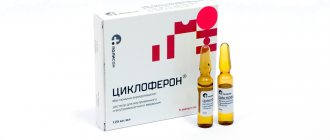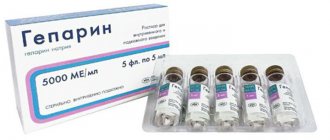Pharmacodynamics and pharmacokinetics
Pharmacodynamics
Strophanthin is a cardiac glycoside , the mechanism of action of which is reduced to the blockade of Na+/K+-ATPase, as a result of which the sodium content in the cardiac muscle cells increases and channels open for calcium to enter the cell, the level of adenosine monophosphate increases and the energy supply of the myocardium improves.
Strophanthin K, isolated from the seeds of Strophanthus Combe, increases the strength of contractions of the heart muscle: systole is shortened, intensified and becomes energy efficient. The stroke and minute volume of blood increases and ventricular emptying improves. As a result, the size of the heart decreases and the need for oxygen decreases.
Glycosides cause prolongation of diastole and slow down the heart rate, which improves metabolic processes in the myocardium and the filling of the chambers with blood.
By activating the vagus nerve , glycosides reduce the automaticity of the sinus node.
Thus, Strophanthin normalizes blood circulation indicators . Under its influence, the heart works more economically: it does more work without increasing oxygen consumption.
Pharmacokinetics
Suction
The effect after intravenous injection is 5-10 minutes, maximum effect is 15-30 minutes.
Distribution: 40% binds to blood proteins.
Removal
Excreted in urine. Strophanthin K has a half-life from the blood of 1 day. There is no cumulative effect. Cumulation occurs when heart failure is combined in a patient with serious disorders of bile and urinary excretion.
Contraindications
- increased sensitivity ;
- acute myocarditis , constrictive pericarditis ;
- cardiosclerosis;
- AV block II–III degree;
- atrial extrasystole ;
- myocardial infarction;
- hypertrophic cardiomyopathy ;
- thyrotoxicosis;
- carotid sinus syndrome;
Use with caution in case of a history of Morgagni-Adams-Stokes attacks , subaortic stenosis, cardiac asthma against the background of mitral stenosis, unstable angina, hypoxia , severe dilatation of the heart cavities and electrolyte disturbances (decreased potassium and magnesium, increased calcium and sodium in the blood).
Instructions for use Strophanthin K (Method and dosage)
Due to the high activity and rapid action of the drug, the instructions for use of Strophanthin K must be strictly followed - accuracy in dosage and indications is necessary.
Inject into a vein slowly (over 4-6 minutes), usually 1 ml once a day, after diluting it in 10 ml of glucose or sodium chloride solution. For intravenous drip administration - 1 ml of the drug per 100 ml of sodium chloride or glucose solution. With this type of administration, toxic effects are less likely to be observed. Higher doses for intravenous administration: single - 0.5 mg, daily - 1 mg.
Rarely prescribed intramuscularly. Since intramuscular injections are painful, first inject 5 ml of novocaine solution, then strophanthin + 1 ml of novocaine. For intramuscular use, the dose is increased by 1.5 times.
Use of the drug Strophanthin
IV slowly, maximum single dose - 0.25 mg, daily dose - 1 mg. Strophanthin is administered in low doses - 0.1–0.15 mg with an interval of 30 minutes to 2 hours. At an average rate of digitalization during the saturation period, 0.25 mg is usually administered 2 times a day with an interval of 12 hours. Duration of the saturation period on average is 2 days. The maintenance dose of strophanthin, as a rule, does not exceed 0.25 mg/day. Oral strophanthin tablets are prescribed at 0.00025 g 2-3 times a day, under ECG monitoring, the dose is selected individually; The maintenance dose is usually 0.00025 g 1–2 times a day. The daily dose should not exceed 0.001 g.
Overdose
Glycoside intoxication manifests itself in decreased appetite , vomiting and heart rhythm disturbances (ventricular tachycardia and extrasystole, nodal tachycardia, atrial fibrillation, AV block).
Dizziness, headache, paresthesia, and decreased visual acuity appear In such cases, cardiac glycosides are discontinued, antidotes are administered and symptomatic therapy is carried out: antiarrhythmic drugs, intravenous administration of potassium chloride. In case of complete blockade, accompanied by Morgagni-Adams-Stokes attacks, cardiac pacing is performed.
Overdose of the drug Strophanthin, symptoms and treatment
Symptoms of strophanthin overdose (glycoside intoxication) are varied. From the cardiovascular system: arrhythmia, including bradycardia, AV block, ventricular tachycardia or extrasystole, ventricular fibrillation. From the digestive tract: anorexia, nausea, vomiting, diarrhea. From the central nervous system and sensory organs: headache, increased fatigue, dizziness, rarely - coloring of surrounding objects in green and yellow colors, flashing of spots before the eyes, decreased visual acuity, scotoma, macro- and micropsia; very rarely - confusion, syncope. If glycoside intoxication develops, strophanthin should be discontinued; prescribe potassium supplements to the patient, administer unithiol parenterally, and carry out symptomatic therapy.
List of pharmacies where you can buy Strophanthin:
- Moscow
- Saint Petersburg
Interaction
The likelihood of heart rhythm disturbances increases with the simultaneous use of methylxanthines (caffeine, paraxanthine, theophylline, theobromine ), tricyclic antidepressants ( imipramine , amiltriptyline, nortriptyline) and adrenergic stimulants .
AV conduction is enhanced by beta-blockers, Quinidine, Novocainamide, Disopyramide, Aymalin, Verapamil and Magnesium Sulfate .
Quinidine, Methyldopa, Veroshpiron, Amiodarone, Verapamil, Clonidine, Captopril, Erythromycin and Tetracycline increase the concentration of cardiac glycosides in the blood .
When used together with thiazide diuretics and glucocorticosteroids, the toxic effect of glycosides increases due to the occurrence of hypokalemia.
Drug interactions Strophanthin
The simultaneous use of strophanthin with sympathomimetics, methylxanthines, reserpine and tricyclic antidepressants increases the risk of developing arrhythmia. The concentration of strophanthin in the blood plasma increases with the simultaneous administration of quinidine, amiodarone, captopril, calcium antagonists, erythromycin and tetracyclines. Saluretics, ACTH, corticosteroids, insulin, calcium preparations, laxatives, carbenoxolone, amphotericin B, benzylpenicillin, salicylates increase the risk of developing glycoside intoxication. Antiarrhythmic drugs, including beta-adrenergic receptor blockers, potentiate the negative chrono- and dromotropic effects of the glycoside. Inducers of microsomal liver enzymes (phenytoin, rifampicin, phenobarbital, phenylbutazone, spironolactone), as well as neomycin and cytostatic agents reduce the concentration of strophanthin in the blood plasma. Calcium supplements increase sensitivity to cardiac glycosides.
special instructions
Strophanthin causes hypertension in the pulmonary artery, and therefore can provoke pulmonary edema with mitral stenosis. In WPW syndrome, the drug can provoke an attack of paroxysmal tachycardia.
The likelihood of intoxication increases with hypothyroidism, myocarditis, hypokalemia, hypomagnesemia, dilation of the heart cavities, hypercalcemia, hypernatremia , cor pulmonale and obesity .
With rapid intravenous administration, there is a risk of developing bradyarrhythmia and cardiac arrest . extrasystole may appear . To prevent these effects, the dose is divided into 2-3 injections.
If the patient was previously prescribed cardiac glycosides, you need to take a break for 7-24 days - this depends on the cumulative properties of the previous drug. To avoid side effects, treatment is carried out under the control of an ECG and the level of digitalization (blood test).
Name: Strophanthin-KName (Latin): Strophanthin-K
Gross formula: C30H44O9
Chemical Compound: (3beta,5beta)-/(2,6-Dideoxy-3-O-methyl-beta-D-ribohexopyranosyl)oxy/-5,14-dihydroxy-19-oxocard-20(22)-enolide
CAS code: 508-77-0
Update date: 16/07/1999
Classification according to ICD-10: [I47.1] Supraventricular tachycardia [I48] Atrial fibrillation and flutter [I50.0] Congestive heart failure [I50.1] Left ventricular failure
Pharmacological groups: Cardiac glycosides and non-glycoside cardiotonic drugs
Pharmacological action: cardiotonic
Pharmacology: Shows positive ino- and bathmotropic, negative chrono- and dromotropic effects, inhibits Na+-K+-ATPase of myocardiocytes. After intravenous administration, the effect appears after 5-10 minutes, reaching a maximum after 15-30 minutes. Has little effect on heart rate and bundle conduction. In the blood, only a small part (5%) binds to proteins. Completely excreted in urine within 24 hours. Does not accumulate.
Characteristics: White or white with a slightly yellowish tint crystalline powder, sparingly soluble in water and alcohol.
Application: Acute cardiovascular failure, chronic circulatory failure stage II-III, especially with the ineffectiveness of digitalis drugs, supraventricular tachycardia, atrial fibrillation and flutter.
Contraindications: Hypersensitivity, organic lesions of the heart and blood vessels, acute myocarditis, endocarditis, severe cardiosclerosis, acute myocardial infarction, AV block II-III degree, hypertrophic obstructive cardiomyopathy and constrictive pericarditis, carotid sinus syndrome, intoxication with cardiac glycosides, thyrotoxicosis, atrial extrasystole (possible transition to atrial fibrillation).
Side effects: Arrhythmia, nausea, vomiting, diarrhea, mesenteric infarction, headache, weakness, insomnia, depression, hallucinations, psychosis, visual disturbances, gynecomastia.
Interaction: Calcium antagonists (especially verapamil) and amiodarone slow down excretion and increase plasma concentrations (if combined use is necessary, the dose of strophanthin-K should be reduced by 2 times). Sympathomimetics, calcium salts and antiarrhythmic drugs increase the risk of arrhythmias. Against the background of magnesium sulfate, the likelihood of decreased conductivity and AV heart block increases.
Precautions: With rapid intravenous administration, bradyarrhythmia, ventricular tachycardia, AV block and cardiac arrest may develop. At the peak of the effect, extrasystoles may appear, sometimes in the form of bigeminy. To prevent this effect, the dose can be divided into 2-3 intravenous administrations or one of the doses is administered intramuscularly. Before the intramuscular injection, 5 ml of a 2% novocaine solution is administered, then, without removing the needle, strophanthin-K; the effectiveness of IM application is 2 times lower. If the patient has previously been prescribed other cardiac glycosides, it is necessary to take a break before the intravenous administration of strophanthin-K (5-24 days, depending on their pronounced cumulative properties). Treatment is carried out under constant ECG monitoring.
Structural formula:
Trade names:
Strophanthidin acetate
Strophanthidin acetate solution for injection 0.05%
Strophanthin K
Strophanthin K injection solution
Reviews
Only a doctor can prescribe this drug - self-medication is excluded! Doctors' warnings are completely justified: cardiac glycosides (CG) are strong cardiotonics , which, if overdosed or incorrectly prescribed, have adverse reactions, including severe, life-threatening ones. They should be used with caution, paying attention to compatibility with other drugs.
Features of the pharmacokinetics of SG dictate the indications for their use. According to doctors, Strophanthin (glycoside from strophanthus seeds) and Korglykon (lily of the valley glycoside) have a systolic effect, and Celanide (digitalis glycoside) has a diastolic effect. The first two drugs have a low ability to accumulate and act quickly. Celanide has a stronger, but slowly developing cardiotonic effect that persists for a long time. Digitoxin is a representative of long-acting glycosides with a pronounced ability to cumulate. Treatment of HS is carried out under close medical supervision.

